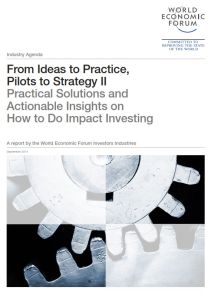Join getAbstract to access the summary!

Join getAbstract to access the summary!
Abigail Noble, Marina Leytes, Ann Brady and Fabienne Stassen (eds.)
From Ideas to Practice, Pilots to Strategy II
Practical Solutions and Actionable Insights on How to Do Impact Investing
World Economic Forum, 2014
What's inside?
Impact investing works to achieve a social or environmental goal by offering attractive financial opportunities.
Recommendation
Impact investing, the practice of investing in companies dedicated to furthering a social or environmental goal, is gaining traction. Contrary to popular belief, investing for social good does not necessarily mean sacrificing returns. In fact, many of these vehicles offer current yield, stability and, perhaps, modest growth. These features have attracted institutional investors for years, and now impact investment products with mass appeal are hitting the retail market. While this World Economic Forum study – edited by WEF’s Abigail Noble, Marina Leytes and Ann Brady as well as former WEF editor Fabienne Stassen – does a good job of assessing impact investing from a variety of standpoints, the quality of the writing is at best uneven, and some of the articles come uncomfortably close to pitching a product or service. Given that 16 experts contributed to the report, such pitfalls might just come with the territory. Nonetheless, getAbstract recommends this compendium to individual and institutional investors, brokerage firms, financial advisers, and others interested in the growing market for impact investments.
Summary
About the Authors
Abigail Noble is head of impact investment initiatives at the World Economic Forum, where Marina Leytes is project manager and Ann Brady is head of editing. Fabienne Stassen is a former chief editor at WEF.

















Comment on this summary